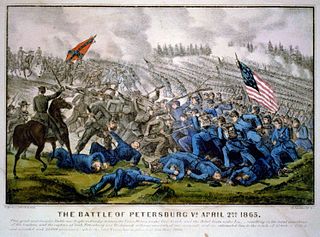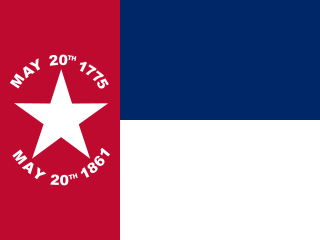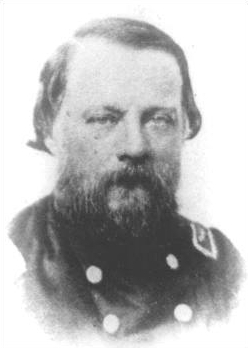
The Third Battle of Petersburg, also known as the Breakthrough at Petersburg or the Fall of Petersburg, was fought on April 2, 1865, south and southwest Virginia in the area of Petersburg, Virginia, at the end of the 292-day Richmond–Petersburg Campaign and in the beginning stage of the Appomattox Campaign near the conclusion of the American Civil War. The Union Army under the overall command of General-in-Chief Lieutenant General Ulysses S. Grant, launched an assault on General Robert E. Lee's Confederate Army of Northern Virginia's Petersburg, Virginia, trenches and fortifications after the Union victory at the Battle of Five Forks on April 1, 1865. As a result of that battle the Confederate right flank and rear were exposed. The remaining supply lines were cut and the Confederate defenders were reduced by over 10,000 men killed, wounded, taken prisoner or in flight.

The Appomattox campaign was a series of American Civil War battles fought March 29 – April 9, 1865, in Virginia that concluded with the surrender of Confederate General Robert E. Lee's Army of Northern Virginia to forces of the Union Army under the overall command of Lieutenant General Ulysses S. Grant, marking the effective end of the war.

The 205th Pennsylvania Infantry was an infantry regiment of the Union Army during the American Civil War. It was raised during the final war year in response to President Lincoln's call for 500,000 volunteers. The regiment joined the IX Corps to counter General Lee's final offensive thrust at Ford Stedman and attacked to break through the Petersburg defenses one week before his final surrender at Appomattox. It participated in the Grand Review of the Armies and was mustered out in June 1865.
The 58th Regiment, Pennsylvania Volunteer Infantry was an infantry regiment which served in the Union Army during the American Civil War.
The 61st Regiment Massachusetts Volunteer Infantry was an infantry regiment raised for one year's service in the Union Army during the American Civil War from 1864 to 1865.

The 1st Virginia Infantry Regiment was an infantry regiment raised in the Commonwealth of Virginia for service in the Confederate States Army during the American Civil War. It fought mostly with the Army of Northern Virginia.

The 6th Virginia Infantry Regiment was an infantry regiment raised in Virginia for service in the Confederate States Army during the American Civil War. It fought mostly with the Army of Northern Virginia.

The 9th Virginia Infantry Regiment was an infantry regiment raised in Virginia for service in the Confederate States Army during the American Civil War. It fought mostly with the Army of Northern Virginia.

The 12th Virginia Infantry Regiment was an infantry regiment mostly raised in Petersburg, Virginia, for service in the Confederate States Army during the American Civil War, but with units from the cities of Norfolk and Richmond, and Greensville and Brunswick counties in southeastern Virginia. It fought mostly with the Army of Northern Virginia.

The 16th Virginia Infantry Regiment was an infantry regiment raised in 1861 in Portsmouth in southeastern Virginia for service in the Confederate States Army during the American Civil War. The regiment fought almost exclusively with the Confederate Army of Northern Virginia.

The 18th Virginia Infantry Regiment was an infantry regiment raised in Virginia for service in the Confederate States Army during the American Civil War. It fought mostly with the Army of Northern Virginia.

The 41st Virginia Infantry Regiment was an infantry regiment raised in the Commonwealth of Virginia for service in the Confederate States Army during the American Civil War. It fought mostly with the Army of Northern Virginia in Longstreet's corps and, later, that army's Third Corps.

David Addison Weisiger was a Confederate States Army brigadier general during the American Civil War. Weisiger served as a second lieutenant in the 1st Virginia Volunteers, an infantry regiment, during the Mexican–American War. After the war, he became a leading businessman in Petersburg, Virginia. Between 1853 and 1860, he served in the 39th Virginia Militia Regiment, rising from captain to colonel. After the Civil War, he was a bank cashier at Petersburg, Virginia and a businessman at Richmond, Virginia.

The 61st New York Infantry Regiment, also known as the "Astor Regiment", was an infantry regiment of the Union Army during the American Civil War.
The 21st Connecticut Infantry Regiment was an infantry regiment that served in the Union Army during the American Civil War.

The 20th North Carolina Infantry Regiment was an infantry regiment in the Confederate States Army. It was part of the Army of Northern Virginia for most of the war.
The 36th United States Colored Infantry was an infantry regiment that served in the Union Army during the American Civil War. The regiment was composed of African American enlisted men commanded by white officers and was authorized by the Bureau of Colored Troops which was created by the United States War Department on May 22, 1863.

The 211th Regiment Pennsylvania Volunteer Infantry was an infantry regiment of the Union Army in the American Civil War. Raised in western Pennsylvania in September 1864, the regiment initially served with the Army of the James during the Siege of Petersburg, holding trenches at Bermuda Hundred. In late November it transferred to the Army of the Potomac and during the northern hemisphere spring campaign fought in the counterattack during the Battle of Fort Stedman and the Union breakthrough at Petersburg. During the last days of the Appomattox Campaign it guarded trains, and participated in the Grand Review of the Armies following the end of the war before mustering out.

The 199th Regiment Pennsylvania Volunteer Infantry, alternately known as the Commercial Regiment, was an infantry regiment of the Union Army in the American Civil War. Raised in Philadelphia in late 1864, the regiment enlisted for one year and was sent to the Army of the James during the Siege of Petersburg. During the Third Battle of Petersburg it assaulted Forts Gregg and Alexander, then pursued the retreating Confederate Army of Northern Virginia, fighting at Rice's Station and Appomattox Court House. Following the Confederate surrender at Appomattox, the regiment moved to Richmond, where it mustered out in late June 1865.

The 1st Louisiana Infantry Regiment was a unit of volunteers recruited in Louisiana that fought in the Confederate States Army during the American Civil War. Formed in April 1861, the regiment was sent to fight in the Eastern Theater of the American Civil War. Joining a brigade of Louisiana regiments, it fought at Malvern Hill, Second Bull Run, Antietam, and Fredericksburg in 1862, at Chancellorsville, Second Winchester, Gettysburg, and Mine Run in 1863, and at the Wilderness, Spotsylvania, Monocacy, Third Winchester, Fisher's Hill, Cedar Creek, and Petersburg in 1864, and at Appomattox in 1865. At Appomattox, the regiment was only a shadow of its former self.










